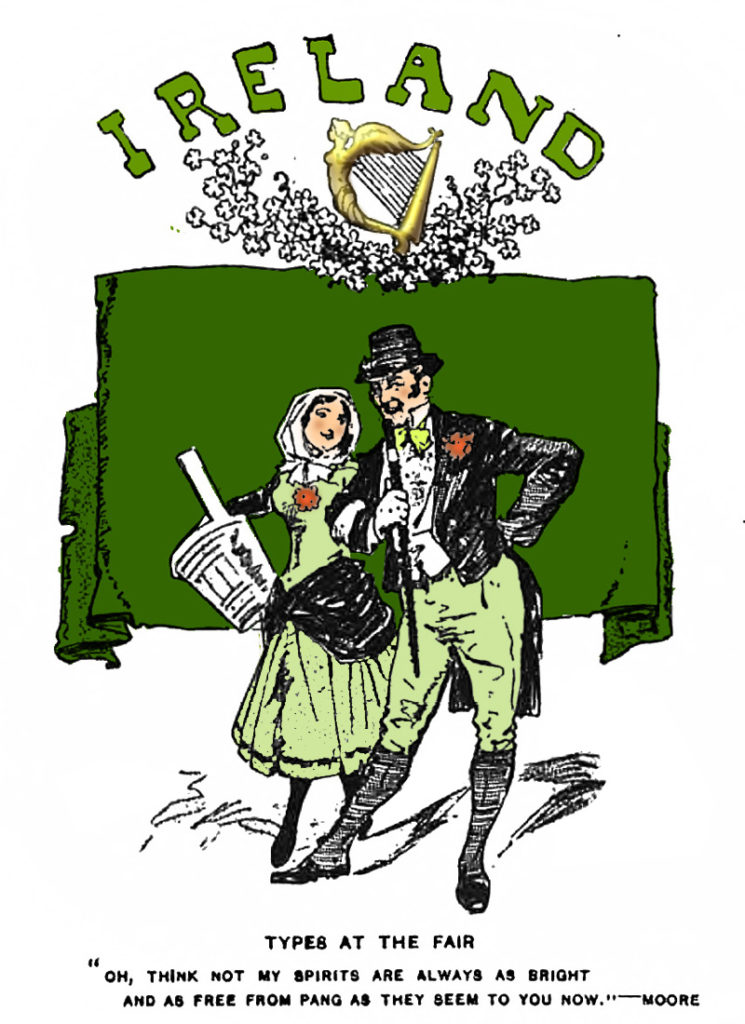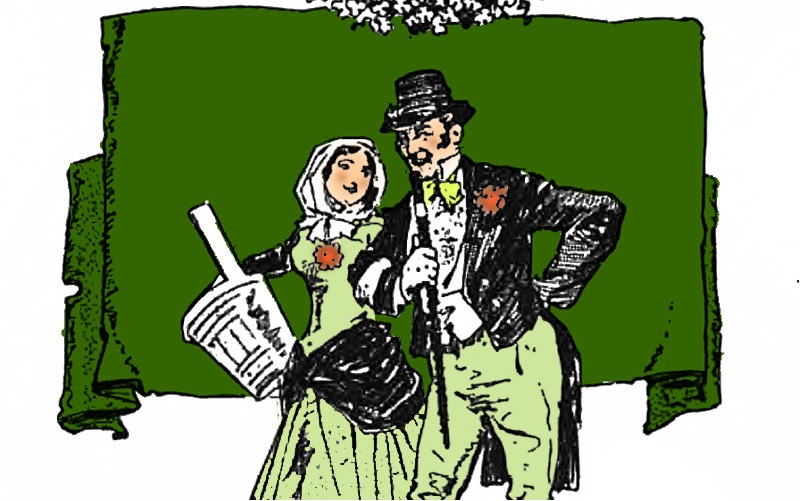
“Types of the Fair” [Adapted from a drawing in Current Literature June 1893.]
In her essay about Ireland, published in the July 1893 issue of the North American Review, Lady Aberdeen sets out to describe the contributions of the Irish people to the 1893 World’s Fair, but quickly shifts to Irish politics and a critique of Irish immigration to the new world.
We present here an excerpt of her article, in which she offers an affectionate description of the Irish Village on the Midway Plaisance of the Columbian Exposition. She had organized the exhibit, which often was referred to as “Lady Aberdeen’s Irish Village.”
__________________________________________________________________
From the North American Review July 1893 p. 20 [public domain].
IRELAND AT THE WORLD’S FAIR.
BY THE RIGHT HON. THE COUNTESS OF ABERDEEN
It is a wonderful creation, that city of white palaces amongst the gleaming waters and waving verdure, at which the people of the New World are calling the nations of the earth to assemble, and where we may wander for long hours amidst the marvels of art and industry and science and nature, gathered from every land. And it is but fitting that this great Exposition, which seeks to represent every phase of life on the earth, should not only invite to her halls the wise, the great, the eloquent, the learned and the leaders of the peoples together in order to demonstrate the common brotherhood of all mankind, but that, hard by her palaces, we should find a place set apart where the common, every-day life or all sorts and conditions of men of various nations of the world may be witnessed by the most stay-at-home of Americans.
And, if we mistake not, many of the visitors to the World’s Fair, who are also lovers of human nature, will own to themselves that they have carried away more vivid remembrances of the doings and ways of men and nations as illustrated on the Midway Plaisance, than even of their most wonderful handiwork as seen in the show-cases of the great buildings.
In this common camping-ground we may betake ourselves to one of the temples of ancient Egypt, hundreds of years before Christ; we may become explorers of Central Africa and the huts of the Soudanese, enlivened by the tom-toms of the comely black musicians, or we may watch the jesters and the jugglers of the East, still puzzling, with their tricks, the magicians of the West. Or we can turn from all the brilliant coloring and gay wares shown us by the Chinese and Japanese, to find ourselves amongst the quaint little Esquimaux and Laplanders, who, perhaps, seem most out of place amidst all this sun and radiance. Or, again, we may wander amongst the savage tribes of the South Sea Islands; or, if we will, we may spend our summer afternoons dozing under a tree listening to martial music amidst surroundings which must make us wake with a start to wonder if we are, indeed, subjects of the Kaiser Wilhelm.
And to what end have all these shows and sights been brought here at such vast trouble and expense? Many nations have doubtless combined to bring about this panorama. Not only have the promoters of the World’s Fair desired to see it as complete in every detail as possible, but no nation was willing to be unrepresented here, or to lose a chance of participating in the spoils to be expected as the result of this peaceful contest of competition.
“World’s Columbian Exposition, Midway Plaisance, Irish Village” photograph by C.D. Arnold. [Image from Ryerson & Burnham Archives, Art Institute of Chicago.]
“Blarney Castle” by Charles Graham. [Image from The World’s Fair in Water Colors by Charles Graham, 1893.]
But it is in the actual dwellers and workers in the village that the interest will chiefly concentrate, for whatever may be the defects in the imitations we have made of inanimate things these newly imported lads and lasses show their origin plainly enough, with their rosy cheeks–the tint of which some doubting American visitors have been rash enough to hint must be artificial–and their deft hands plying needle or loom or wheel or carving-tools with equal dexterity. If it is impossible absolutely to represent a quiet and peaceful cottage life in the wilds of Ireland in a place where thousands of visitors pass daily, yet this comes as near the original as circumstances will permit, and we believe that the remembrances of the past which the sight will recall, with the aspirations which it will renew of being a credit and an honor to the old people, the old home, the old country in this now world, in whose history and life the Irish element counts for so much–these remembrances and aspirations must be full of wholesomeness and help.
But was it merely the purpose of inspiring such sentiments, noble as they may be, that induced the “Irish Industries Association” to set down this little industrial colony in the World’s Fair, at the cost of considerable trouble and at the risk of many thousands of dollars advanced for the purpose by kind friends both in the old country and in America? No. The mission intrusted to us by the people of Ireland, represented as they are in our councils by persons of all classes, all denominations of religion, and all sections of politics, is one of wide and practical importance to the poor of Ireland, and not only has it been taken heartily in hand by our Committee but it has been enthusiastically indorsed by many public meetings in different parts of Ireland. We not only desire to represent the life of some of Ireland’s peasantry, but we desire to appeal through their skill and quickness and dexterity to Ireland’s friends and to show that through these qualities a great work can be done for Ireland.
What has been the reason for the great decrease in the population of Ireland? What has been her curse, apart from (although in great measure owing to) England’s misgovernment? Is it not that her people have mainly relied on the land for their sustenance, and that any bad season or other mischance has found them with no other means of living to resort to? And so they have had to face one of two alternatives: practical starvation at home or emigration. And this amongst a people who not only have an intense love of home, but who appear naturally to possess industrial aptitude, calculated to make their country prosperous! Need these things be? Although the new countries of the West are goodly lands of hope for the emigrant, yet need Ireland be depopulated yearly of the flower of her young men and maidens who cling to home and parents despite all hardships and scanty fare, and who part from their country with a sore wrench never wholly forgotten throughout life? And all the while there is running to waste not only the manual dexterity referred to, but a whole treasury of water-power, and seas teeming with fish.
…
Need our objects in planting the Irish village at Chicago be further inquired into? We seek to remind not only the Irish-Americans but the American public generally of the work of the Irish peasantry; we desire to secure not only their custom, but their hearty support of the movement in its development; and we are sanguine that we shall not appeal in vain for what we confidently believe will largely tend to the uplifting of a whole country.
ISHBEL ABERDEEN.
“Scenes in the Irish Village” by Charles Graham. [Image from The World’s Fair in Water Colors by Charles Graham, 1893.]

